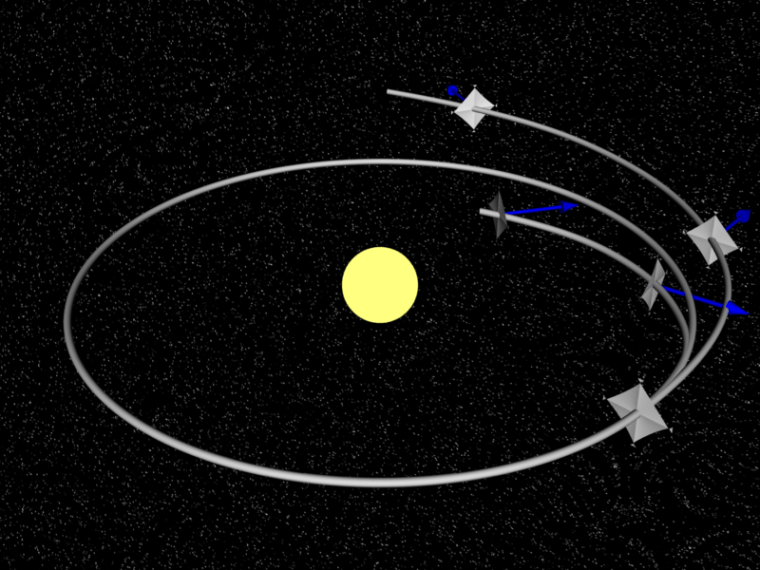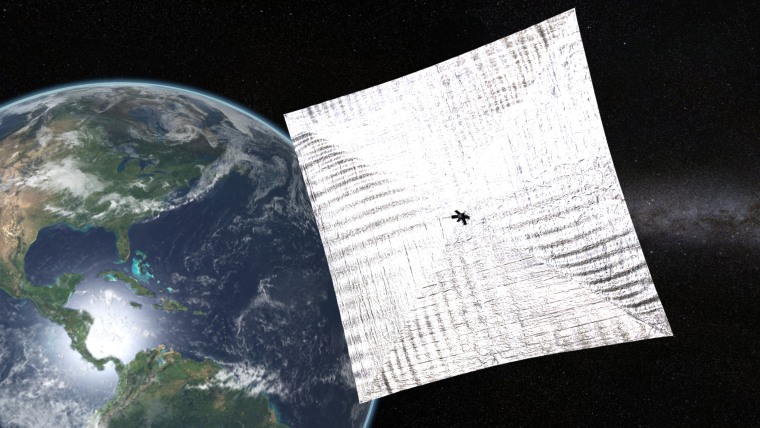The Planetary Society's first LightSail mission, due for launch on Wednesday, may be just one small step for a technology that could one day send spaceships to the stars, propelled by solar sails. But it's a giant leap in the eyes of Bill Nye the Science Guy, the society's chief executive officer.
"This has been my old professor Carl Sagan's dream for over 39 years," Nye said in comments emailed to NBC News on the eve of the launch. "With a successful flight, this will be an example of democratizing space."
LightSail is one of 10 compact CubeSat nanosatellites set for deployment after the launch of a United Launch Alliance Atlas 5 rocket from Cape Canaveral Air Force Station in Florida.
The main payload is the U.S. Air Force's X-37B space plane, which is expected to conduct a classified, months-long test mission in orbit. Forecasters say the weather conditions are 60 percent favorable for liftoff during a window that extends from 10:45 a.m. to 2:45 p.m. ET Wednesday. United Launch Alliance is planning a webcast of the launch via its website as well as the Planetary Society's website. (A separate video stream is optimized for mobile devices.)
Just as the X-37B hints at the future of military spaceflight, LightSail hints at the prospects for a type of star-trekking that astronomers and science-fiction writers have dreamt of for centuries.
The basic idea goes back to the early 17th century, when astronomer Johannes Kepler observed that the material in a comet's tail seemed to be blown around by a "breeze" from the sun. Perhaps future sailing ships could navigate their way from space using that solar breeze, he said.
Since then, the idea has taken hold in fiction as well as fact: On the fictional side, Count Dooku used an solar sailing ship as a getaway vehicle in the "Star Wars" saga. In real life, NASA took advantage of the solar sail concept in the 1960s and 1970s to help stabilize its Mariner spacecraft. In 2010, Japan steered its Ikaros solar sail through an unprecedented deep-space test flight. A NASA mission called NanoSail-D2 came later.
How solar sailing works
The key to the concept is an ultralight, ultra-thin sail. The LightSail spacecraft is only about the size of a loaf of bread, but a 344-square-foot (32-square-meter) spread of Mylar plastic is carefully folded inside. After deployment, the shiny plastic will be unfurled — and then directed into the "wind" of sunlight.
Various forms of radiation are constantly streaming outward from the sun. One type of radiation, consisting of charged subatomic particles, is actually known as the solar wind. But that's not the type of breeze used for solar sailing. Instead, photons — that is, particles of light — will impart momentum to the Mylar sail.
"The resulting acceleration is small, but continuous," Nye said during a preview of the mission. That slow but steady acceleration isn't well-suited for going from Earth into space, or for going from Earth orbit to the moon. But the velocity builds up as long as the photons are pushing.
Dean Alhorn, who was the principal investigator for NanoSail-D2 at NASA's Marshall Space Flight Center, noted that the twin Voyager spacecraft have just now reached the edges of interstellar space, more than 30 years after they were launched. "A solar sail would have done that in less than half that time," Alhorn told NBC News.

From Cosmos to LightSail
The big picture is what appealed to Sagan, one of the founders of the Planetary Society — and to his successors. Back in 2005, the society arranged to put a solar-sail prototype aboard a Russian submarine-launched rocket, but the Cosmos 1 mission failed when the rocket went awry.
The objectives of this week's LightSail mission are to test the deployment of the spacecraft and its solar sail. The craft will communicate with university-run ground stations at Cal Poly and Georgia Tech. Amateur radio operators might also be able to catch LightSail's signal by tuning their receivers to 437.435 MHz. (Check out this Planetary Society blog posting for details.)
Nye considers LightSail to be "the people's spacecraft" because the project is being funded by private contributions, including proceeds from a Kickstarter campaign. The total project cost is estimated at $5.45 million.
The initial shakedown cruise, technically known as LightSail-A, is expected to last only about a month. The solar sail is due to be deployed at the 28-day mark, after a series of in-orbit tests. Tiny cameras on the spacecraft will capture pictures of the sail and its cosmic backdrop for transmission down to Earth.
"About one week after sail deployment, with its work finished, LightSail's orbit will decay due to atmospheric drag, and it will burn up on re-entry into the Earth's atmosphere," the Planetary Society said in its Kickstarter timeline.
LightSail-A will be followed next year by a more ambitious outing, known as LightSail-B. LightSail-B will be launched into a higher orbit, as a secondary payload on a SpaceX Falcon Heavy rocket. Next year's mission is expected to provide the first opportunity for mission controllers to steer the sail.
The future of solar sailing
Alhorn noted that the higher a solar sail goes, the easier it is to fly. "The problem is that if you were to do it right around the Earth, you still have small particulates in the upper atmosphere," he said. "That tends to slow you down. Above 800 kilometers [500 miles], beyond that point, you can do some sailing around."
When it comes to solar sails, size matters. NASA's NanoSail-D2, which was deployed in 2011 after some hiccups, carried a 10-square-meter solar sail — which is less than a third of LightSail's area.
Similarly, NASA's next solar sail will dwarf LightSail. Near Earth Asteroid Scout is scheduled for launch as a secondary payload on the first test flight of NASA's heavy-lift Space Launch System in 2018, with a sail that spreads out to 85 square meters (914 square feet) in area. That's the equivalent of a two-bedroom apartment, area-wise.
NEA Scout's principal investigator at Marshall Space Flight Center, Les Johnson, said the Planetary Society will be sharing information about the outcome of the LightSail project. "We have a really great dialogue with them on this flight," he told NBC News.
While the LightSail demonstration missions are restricted to Earth orbit, NEA Scout will use solar sailing the way it's meant to be used: to go into deep space, like Count Dooku. The destination won't be a galaxy far, far away, however. The current target is a near-Earth asteroid known as 1999 VG — which was once touted as a potential alien probe. Not a bad choice ... for a technology that sounds like science fiction.

